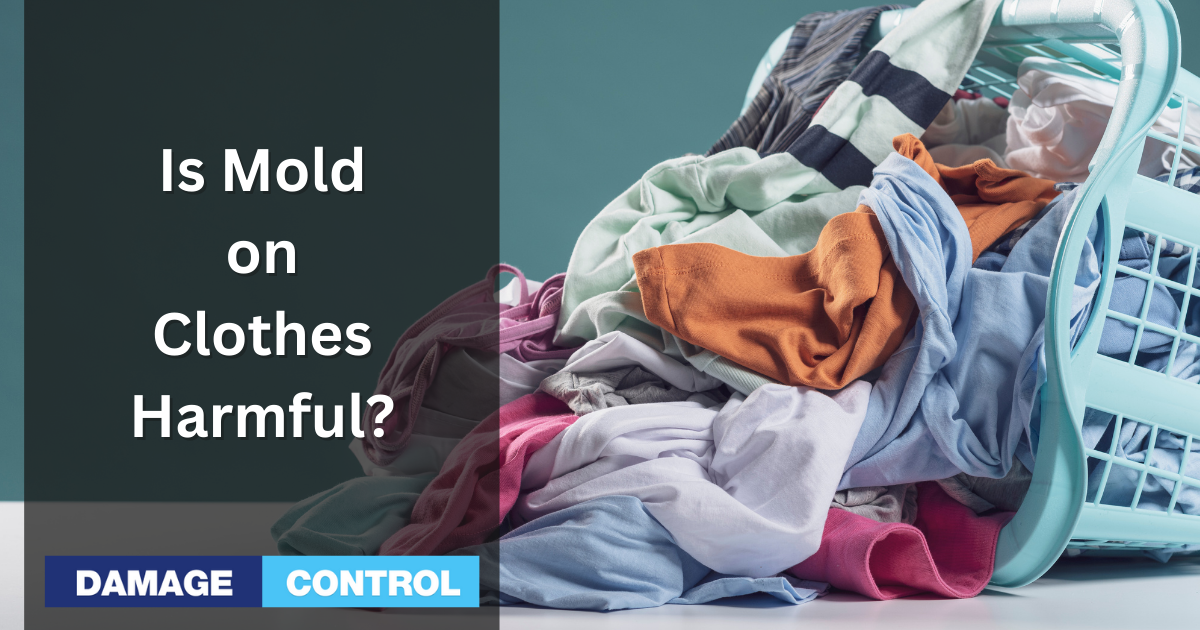Mold is a pervasive problem no matter where it grows in one's home. However, when mold begins to attach itself to items that you use every day, it can become an outright hazard. One of the worst things mold can attach to in your home is your and your family's clothing. Mold-afflicted clothes can be a considerable health hazard if left unchecked.
Here, we will discuss what causes mold to attach itself to your clothes and how mold can affect the health of your skin. We will then cover how to get rid of any mold that may be on your clothes.
How Does Mold End Up on Clothes?
Putting Clothes Away When Damp
Sometimes, when you do a load of laundry and pull the clothes from the dryer, some may seem to be just a touch damp. Now and then, a person may think they can put those somewhat damp clothes away and that the clothes will air dry on their own. However, if the wet clothes are being put in a drawer or in a closet with no airflow, then those clothes will remain damp, facilitating mold growth. Here are some simple steps for cleaning up moldy apparel you may find useful.
Humidity in the Home
It is a simple fact that some homes are more humid than others. It is typically recommended that a home has safe humidity levels between 30% and 50% humidity. Sometimes a home's humidity extends to its closets. If a closet has excessive humidity, the conditions are perfect for mold to grow, as the clothes in the closet provide an ideal place for mold to grow and feed.
Not Drying Clothes Promptly
People are busier than ever in this day and age. It is understandable how sometimes one can throw a wet towel or damp clothes into a dirty bin and forget to wash them after a day. Unfortunately, that means that there is a day or so time for mold to begin building up on clothes. Once the build-up starts, the mold can send its spores out to other areas in your home and latch onto other clothes, especially if your dirty clothes hamper is in your closet.
How Does Mold on Clothes Affect Your Skin?
Allergic Reactions
When mold begins growing on your clothes, you may not notice it at first. This is because mold starts as a microscopic form before accumulating into the dark, visible splotches we most recognize mold as. Some people are naturally allergic to mold, and having it so close to their skin can trigger their allergies. If the clothes emit spores, then there is a good chance the person wearing the clothes is also inhaling the spores, which can trigger allergy-like symptoms.
Irritation
Mold is a corrosive substance, and when it is on a person's skin, it can be a major irritant. It can feel uncomfortable and quite itchy, making things worse if the person wearing the mold-afflicted clothes starts to scratch.
Skin Infections
If a person is wearing mold-afflicted clothes while they have either a minor cut, or they have scratched themselves due to irritation caused by the mold, it can lead to a skin infection that lingers for quite some time. This could lead to a full-blown fungal infection, which comes with its symptoms and should be addressed by a doctor as soon as possible.
Can Trigger or Worsen Eczema
If the person wearing mold-afflicted clothes already suffers from eczema, their clothes may exacerbate their condition. It may even trigger eczema in a person who, up until this point, did not have it.
Severe Mold Skin Conditions
Unfortunately, the previously mentioned conditions are only minor. Worse skin conditions can occur by wearing mold-afflicted clothes.
Mucormycosis
Mucormycosis is a fungal skin infection caused by moles called mucormycetes. It has the following symptoms:
- Swelling on one side of the face
- Sinus congestion
- Fever
- Headaches
- Increasingly severe black lesions on the upper inside of the mouth or nasal bridge
Sporotrichosis
Sporotrichosis is caused by mold typically found in dirt and on plants. It typically appears as a bump that can develop between 1 and 12 weeks after exposure to the mold. This bump can worsen over time and ranges in colors from red, pink, or purple, typically at the site where the mold first made contact with skin.
Invasive Aspergillosis
Invasive Aspergillosis is a condition that is typically caused when Aspergillus mold creates an infection, typically in people who have weakened immune systems. Symptoms are as follows:
- Coughing up blood
- Chest and joint pain
- Headache and eye pain
- Lesions on skin
- Chills and fever
- Shortness of breath
These are pretty nasty problems to deal with.
Common Questions About Clothes With Mold
Should I throw away clothes with mold?
If the mold growth on your clothes has become visible and extensive, you may need to throw the clothes away. However, if the mold growth is not extensive, they may be salvaged.
Will washing clothes kill mold?
Washing your clothes will only kill the mold if you use specialized detergents designed to kill mold. Otherwise, washing your clothes will not affect the mold itself.
How long does it take for mold to ruin clothes?
A piece of clothing can be afflicted by mold in as little as 8 to 12 hours. Depending on the temperature, mold can begin to ruin clothes between 48 and 72 hours.
What happens if you leave mold on your clothes?
The mold will begin to corrode the clothing and ultimately ruin it, emitting more spores into the atmosphere to repeat the process elsewhere.

